 “Yurt is a Turkic word that refers to a portable, round tent common across Central Asia. The word came into English via Russian, but Karakalpaks have their own term for this essential domestic structure – qara u’y, meaning “black house” – because the animal skins they traditionally used to cover the roof and make it watertight became darker over time.
“Yurt is a Turkic word that refers to a portable, round tent common across Central Asia. The word came into English via Russian, but Karakalpaks have their own term for this essential domestic structure – qara u’y, meaning “black house” – because the animal skins they traditionally used to cover the roof and make it watertight became darker over time.
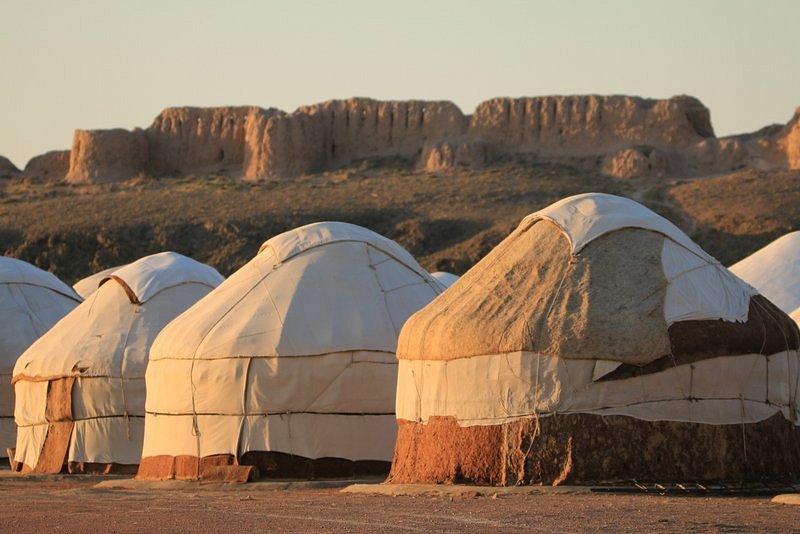 Simple and light to build and transport, it is probably one of the earliest forms of dwelling, and yurts were already commonplace across Eurasia 3,000 years ago. The Greek historian Herodotus (484-425 BC) described the nomadic Scythians as living in yurt-like tents, and you will still occasionally see such homes today, though most are used for entertaining. Yurts are also used for special occasions, for example, for example, Karakalpak families set up a yurt next to their home during wedding celebrations, when it is used for receiving guests and to give the newly married couple some privacy on their special day.
Simple and light to build and transport, it is probably one of the earliest forms of dwelling, and yurts were already commonplace across Eurasia 3,000 years ago. The Greek historian Herodotus (484-425 BC) described the nomadic Scythians as living in yurt-like tents, and you will still occasionally see such homes today, though most are used for entertaining. Yurts are also used for special occasions, for example, for example, Karakalpak families set up a yurt next to their home during wedding celebrations, when it is used for receiving guests and to give the newly married couple some privacy on their special day.
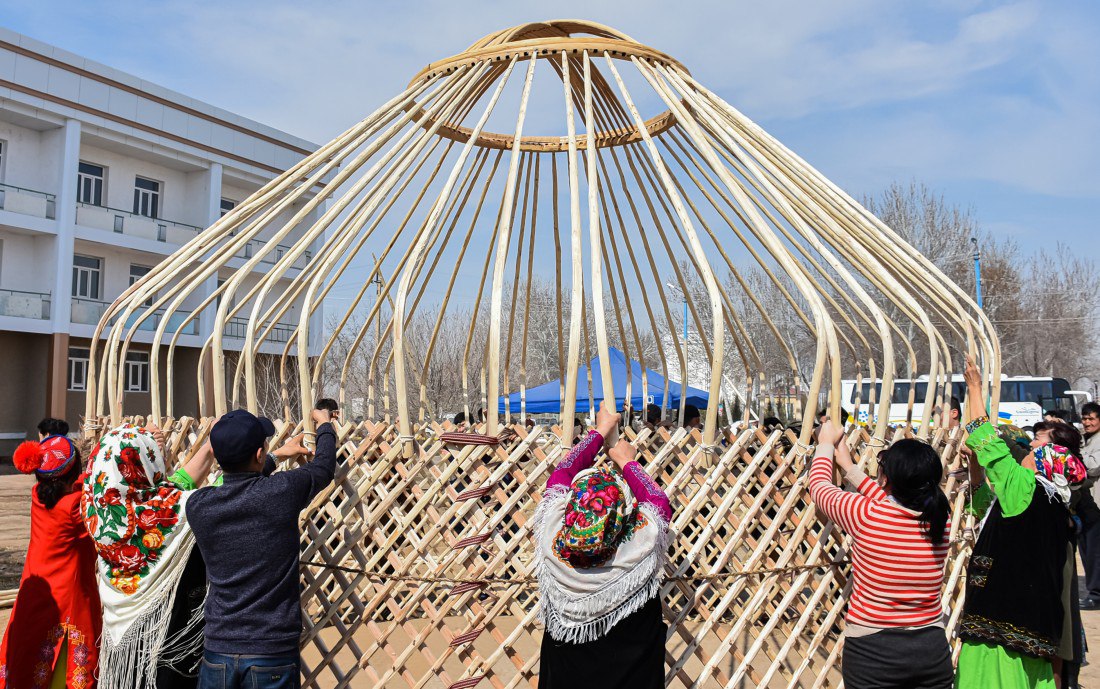 The frame of a yurt is built from a lightweight lattice of wood that can be easily collapsed to transport it on the backs of camels or horses (or, latterly, by truck) from one site to another. In Karakalpakstan, the wood is usually poplar or willow, as both these species of trees grow locally. The wooden strips are bound together with strong bands woven from goat hair or cotton, and the wall and the roof are covered with an insulating felt which is also water-resistant due to natural oils in the fleece. Historically the Karakalpaks didn’t tend to raise sheep and goats themselves as the marshy land around the Aral Sea wasn’t suitable for herding, so they purchased the wool from Kazakh and Turkmen nomads who grazed their flocks on drier pastureland on the fringe of the desert. Often, an additional layer of animal pelt was added to the roof.
The frame of a yurt is built from a lightweight lattice of wood that can be easily collapsed to transport it on the backs of camels or horses (or, latterly, by truck) from one site to another. In Karakalpakstan, the wood is usually poplar or willow, as both these species of trees grow locally. The wooden strips are bound together with strong bands woven from goat hair or cotton, and the wall and the roof are covered with an insulating felt which is also water-resistant due to natural oils in the fleece. Historically the Karakalpaks didn’t tend to raise sheep and goats themselves as the marshy land around the Aral Sea wasn’t suitable for herding, so they purchased the wool from Kazakh and Turkmen nomads who grazed their flocks on drier pastureland on the fringe of the desert. Often, an additional layer of animal pelt was added to the roof.
There are several features that set Karakalpak yurts apart from those of other groups in the region. Firstly, the roof is shaped like a cone rather than a dome, and thus the overall structure tends to be slightly higher. Woven white tent bands crisscross the roof. The wooden frame is much lighter than those used in Uzbek yurts as the Karakalpaks would move their yurts more often as they took their livestock to different pastures; the Uzbek tended to leave the frames in situ in the winter months, simply removing the felt covering. Karakalpaks often also strained the lattice frame a vibrant red, giving the yurt not only a stylistic individuality, but also a special feeling of warmth and comfort.
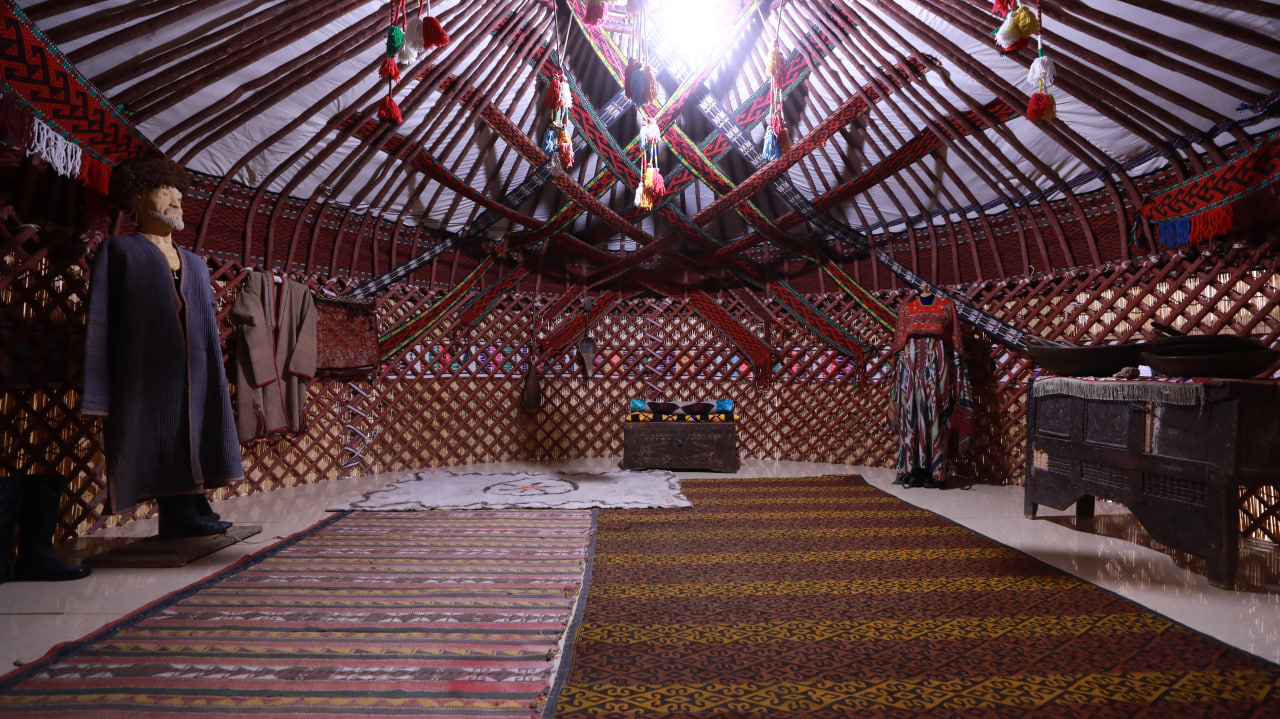 In a traditional Karakalpak design, there are two hinged wooden doors that open inwards, attached to upright struts with a bar across the top. In the past the wood was undecorated, but carved patterns started to become popular in the early 20th century; you can see examples of these in the museums in Nukus and Muynak. In front of the wooden door is a reed screen, an esik, which is not only ornamental but also acts as a draft excluder and is rolled up to allow people to come and go.
In a traditional Karakalpak design, there are two hinged wooden doors that open inwards, attached to upright struts with a bar across the top. In the past the wood was undecorated, but carved patterns started to become popular in the early 20th century; you can see examples of these in the museums in Nukus and Muynak. In front of the wooden door is a reed screen, an esik, which is not only ornamental but also acts as a draft excluder and is rolled up to allow people to come and go.
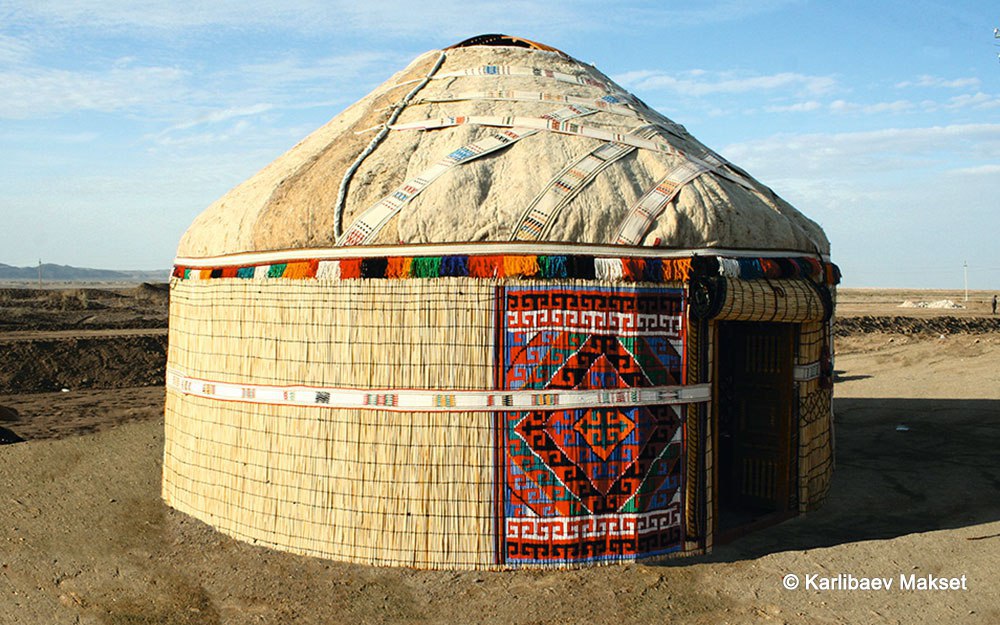 The decoration of a yurt has always been very much a local affair. Until the early 20th century, before a young woman was married, she was expected to make carpets and screens for her future home.
The decoration of a yurt has always been very much a local affair. Until the early 20th century, before a young woman was married, she was expected to make carpets and screens for her future home.
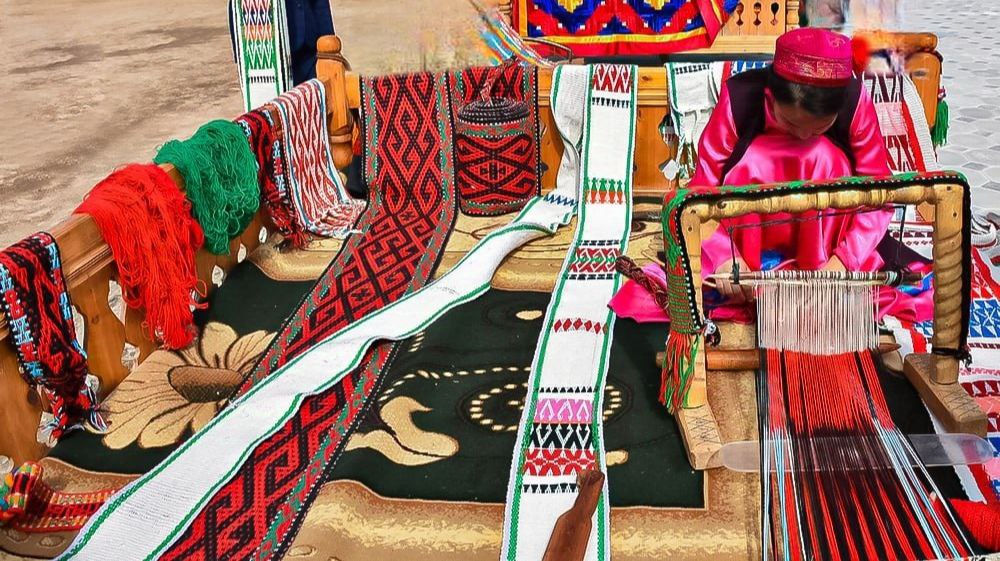 Her mother, sisters, and other older woman in the community would help. One of the most common motifs in Karakalpak weaving is the symbol of ram’s horns, which are usually visible on the textile panels either side of the door, and have had sacred connotations across Central Asia since ancient times.
Her mother, sisters, and other older woman in the community would help. One of the most common motifs in Karakalpak weaving is the symbol of ram’s horns, which are usually visible on the textile panels either side of the door, and have had sacred connotations across Central Asia since ancient times.




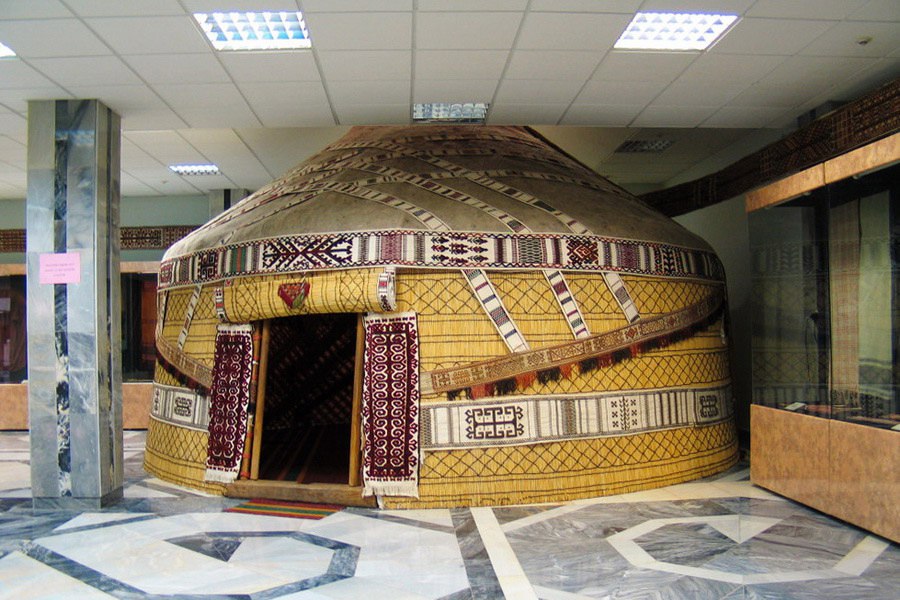 There are plenty of amazing places in Karakalpakstan where you can not only see but also learn about the traditional art of yurts, their unique construction and skillful decoration. Azamat Turekeev and his colleagues from the Kara Uy workshop in Chimbay make yurts following centuries-old traditions, preserving the true spirit of the nomadic people.
There are plenty of amazing places in Karakalpakstan where you can not only see but also learn about the traditional art of yurts, their unique construction and skillful decoration. Azamat Turekeev and his colleagues from the Kara Uy workshop in Chimbay make yurts following centuries-old traditions, preserving the true spirit of the nomadic people.
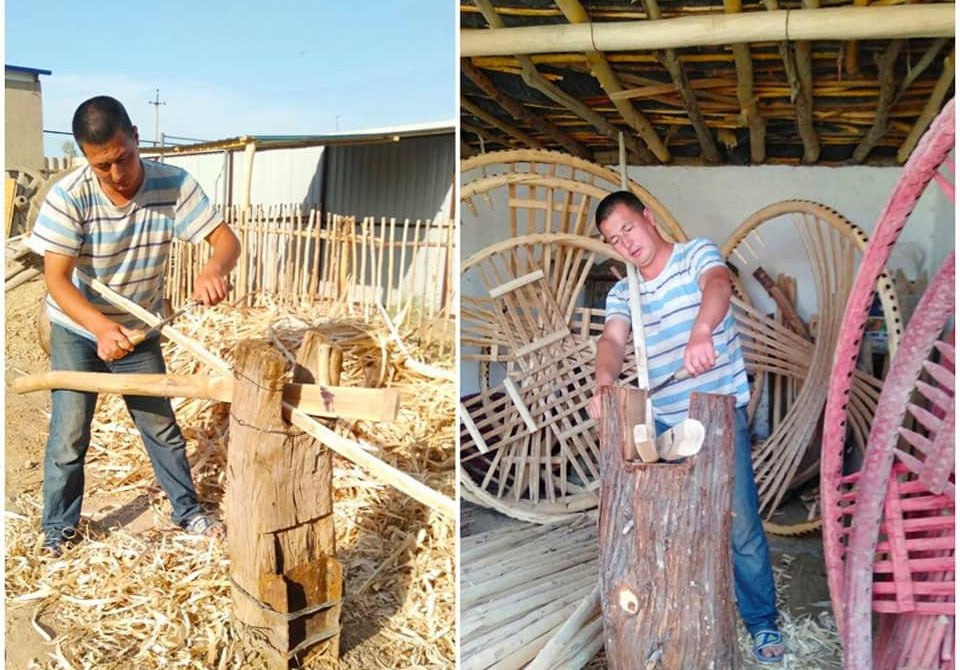
 There are excellent historic examples in the State Museum of the History and Culture of Karakalpakstan, the House Museum of Amet and Ayimkhan Shamuratovs in Nukus and the Ecological Museum of Muynak Region in Muynak.
There are excellent historic examples in the State Museum of the History and Culture of Karakalpakstan, the House Museum of Amet and Ayimkhan Shamuratovs in Nukus and the Ecological Museum of Muynak Region in Muynak.
The Karakalpak yurt, located in the “Ok Kush” complex in the capital of Karakalpakstan, Nukus, has earned its place in the Guinness World Records as the largest non-dismantlable yurt in the world. With an impressive diameter of 40.5 meters and height of 22 meters, it stands as a bright symbol of traditional nomadic life and a true architectural marvel.
 For those who want to fully immerse themselves in the atmosphere of the traditional nomadic way of life, the “Bes Qala” and the “Ayaz Qala” Yurt Camps offer comfortable conditions for spending the night in nature. Here, among the picturesque landscapes, you can not only relax, but also feel the spirit of Karakalpakstan, touch its unique heritage and cultural traditions. In this corner of the world, you will find harmony and inspiration, immersing yourself in endless spaces full of living history and beauty.
For those who want to fully immerse themselves in the atmosphere of the traditional nomadic way of life, the “Bes Qala” and the “Ayaz Qala” Yurt Camps offer comfortable conditions for spending the night in nature. Here, among the picturesque landscapes, you can not only relax, but also feel the spirit of Karakalpakstan, touch its unique heritage and cultural traditions. In this corner of the world, you will find harmony and inspiration, immersing yourself in endless spaces full of living history and beauty.
